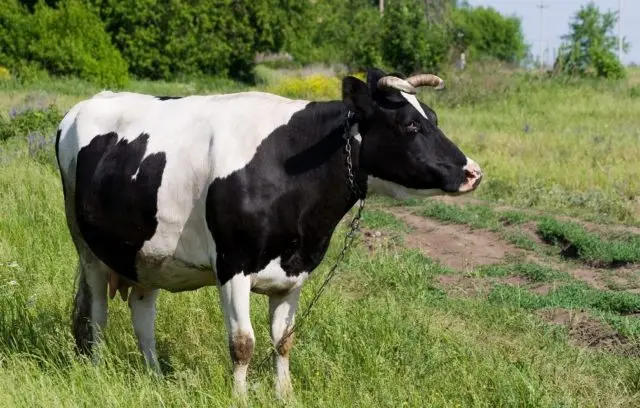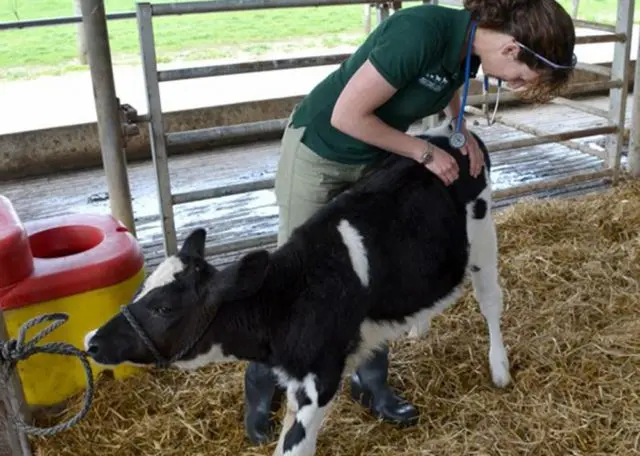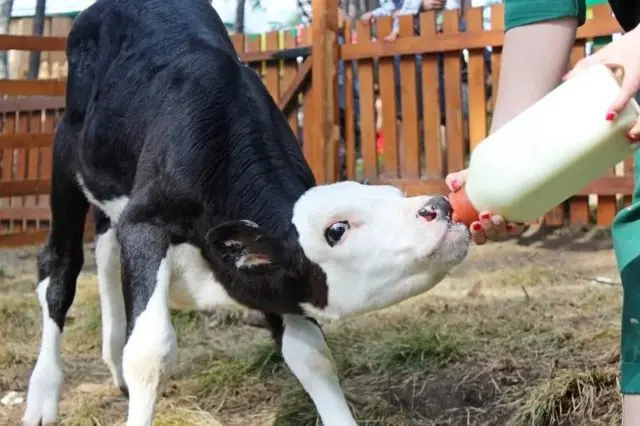Contents
Constipation in a calf, especially during the period of weaning and transfer to roughage, is not uncommon. In adult cows and bulls, such indigestion is most often associated with improper feeding and maintenance. Constipation is often a wake-up call in the diagnosis of diseases of the digestive system of young and adult cattle.

Causes of constipation in cattle
Constipation is a pathological condition that occurs as a result of a malfunction of the digestive system, characterized by a prolonged absence of defecation.
Causes of constipation in adult cattle can be as follows:
- feeding poor-quality, stale or frozen food;
- feeding rotten, moldy or dirty food with impurities of sand, earth and stones;
- feeding unpeeled or insufficiently crushed root crops, pumpkins, corn and other crops;
- the presence of foreign objects in the stomach or intestines (stones, pieces of tissue, plastic bags);
- development of neoplasms in the gastrointestinal tract of the animal.
Constipation in a cow is often one of the signs of the following diseases of the digestive system:
- atony or hypotonia of the proventriculus;
- overflow or timpania of the scar;
- clogging of the book;
- traumatic reticulitis, reticuloperitonitis;
- poisoning.
In calves, digestive problems most often appear at the age of 2-3 months. The main causes of constipation in young cattle are:
- drinking too cold or hot milk;
- drinking stale, sour, contaminated milk;
- a sharp transition when feeding a calf from whole milk to skimmed milk;
- non-compliance with the feeding regimen, daily routine;
- when overfeeding or insufficient feeding of the animal;
- lack of constant access to fresh drinking water;
- a psychological factor, such as weaning from the mother;
- a sharp transition to adult feeding without prior accustoming to eating coarse and succulent feed.
Signs of constipation in cows and calves

The first symptoms of digestive system dysfunction in calves and adult animals, as a rule, begin to disturb and bring discomfort on the second day. Often, even experienced farmers do not immediately determine the presence of an ailment, since a calf or an adult cow does not show any signs of anxiety. In the absence of an act of defecation for more than 1-2 days, the animal can notice obvious signs of illness.
Signs of constipation in calves and cows:
- lethargy, depression;
- animal anxiety and frequent looking at the stomach;
- deterioration or lack of appetite;
- lack of burping and chewing gum;
- the animal lies a lot or walks from corner to corner, hits the stomach with its hind limbs (a common occurrence with constipation lasting more than a day in dairy calves);
- lowing when trying to defecate;
- bloating of the proventriculus, flatulence;
- on rectal examination, there is a lack of normal feces in the rectum, dryness of the mucous membranes and the presence of a fecal plug;
- partial exit of faeces with an abnormal shape and consistency.
How to treat constipation in cows and calves
A delay in defecation for more than a day in an adult or young animal is an alarming symptom. Prolonged absence of defecation can lead to intoxication and death of the animal within 6 hours, depending on the cause of the disease. Such a symptom often accompanies serious diseases of the gastrointestinal tract, so the diagnosis and subsequent treatment of constipation in a calf or cow should be carried out by a veterinarian.
When constipated in dairy calves, the first step is to reduce the amount of milk they drink to reduce and prevent gas and bloating. As a laxative, the animal must be given 100-150 g of vegetable oil. You can also give a laxative enema with warm soapy water, as well as heated mineral or vegetable oils, which soften the stool and facilitate the passage through the intestines.
With swelling, strong rubbing with turpentine diluted with water in a ratio of 1: 1 is effective. In the process of rubbing the abdomen, the calf must be fixed in a standing position – otherwise the procedure will not work.

To prevent constipation in young cattle (especially in dairy calves), you can use the drug sulfadimezin at a dosage of 1 g per head at the first milk feeding and 0,5 g at the next two feedings.
Also, the following drugs are used to treat constipation in calves and adult cattle:
- synthomycin;
- chloramphenicol;
- phthalazole;
- norsulfazol.
The drugs are available in the form of powder and tablets. Before use, the drug should be diluted with warm boiled water and drunk at a dosage of 0,5-1 g per head 30 minutes before drinking milk (preferably on an empty stomach), 3 times a day.
Prevention
During the period of feeding calves with colostrum, it is necessary to strictly observe the feeding regime, in time to accustom the calf to eating coarse and succulent feed. Long breaks between feedings should not be allowed, since a large amount of milk drunk by a hungry calf can get into a net or scar that has not yet developed. Fermented milk that gets into these parts of the stomach can cause serious problems with the gastrointestinal tract.
Calves up to the age of 10 days (in some cases up to 15 days) can be fed only colostrum. The temperature of the milk being drunk should not be lower than +36°С and higher than +40°С, the optimum temperature is +37-38°С.
Also, for the prevention of diseases of the digestive system, calves are recommended to give colostrum fat. This useful product is prepared from fresh colostrum obtained in the first 3 days after summer calving and on the first day after winter calving.
In autumn and spring, young and adult cows should not be pastured after rain, dew, and also after frost.
Do not forget about the observance of zoohygienic standards for keeping cattle. The holding area and feeders should be cleaned, disinfected and checked for foreign objects daily. Dirt that enters the stomach of an animal along with food from dirty drinkers and bedding often causes disruption of the digestive system, as well as the cause of some infectious diseases.
Conclusion
Constipation in a calf or cow is a serious reason to think about the health of the animal. Most often, constipation and other dysfunctions of the digestive system of animals are associated with improper feeding. If signs of constipation appear, the owner, first of all, should seek help from a veterinarian and carefully analyze the daily diet of the animal.









